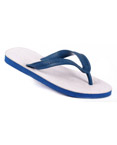Jil Wheeler’s Letter from Mumbai isn’t offensive this time around, just poorly informed. In “The Expat’s New Clothes”, she writes:
If there is one overarching, overwhelming “plus” to living in Mumbai, it is the ability to wear sandals at any time, to any event, no exceptions. At some point in the West, it became cool to hate your feet—to be icked out by toe hair and to insist on wearing socks for sex. We’ve made sandals on men something of a running a joke [sic], and women are warned about the dangers of too much toe cleavage in the workplace.
In India, however, the foot is just fine. Sandals, or chappals, are not only de facto footgear, they’re intimately tied up with national identity. When Gandhi’s pair went up for auction a few months ago, the controversy wasn’t over selling his personal items, it was over selling his sandals. Gandhi made them himself—no musty British footgear for him—and when they sold for over a million dollars, they went to an Indian entrepreneur. India equals sandals, at least in a few minds.
Make that a few half-baked minds. Could Indians prefer sandals to shoes because the climate is so hot and humid? And maybe lace up boots aren’t popular because the country’s cultural norms require the frequent removal of footwear? And perhaps sandals are worn anytime, anywhere, because many Indians don’t own multiple pairs of shoes? No, Indians like sandals because we have these quaint ways.
The rest of Wheeler’s piece isn’t half-bad–there’s a nice bit about learning to tie a sari by watching YouTube–but dear Morning News: please won’t you reconsider Wheeler’s assignment? Or at least halve her per diem till she decides to research her subject before hitting send?
I’d argue that the representative national footwear of India (if there is such a thing) is the flip-flop. Specifically, the rubber Bata Hawaii chappal with blue straps and a white inner sole which, over time, wears away to reveal the blue impressions of big toe and heel. When the straps give up the fight, you can mend the piece at the cobbler’s for a nominal sum.
(Picture from www.bata.in. The pair will set you back by 79 rupees, less than 2USD.)
In The Namesake, when Gogol and his sister visit India, upon reaching the family house, they “have their feet traced onto pieces of paper, and a servant is sent to Bata to bring back rubber slippers for them to wear indoors.” I rest my case.
These slippers were meant to be worn indoors, but you saw them everywhere. When I was a student in India, I had them on every single day, as did everyone; we swapped them for shoes only for job interviews. I wore them like moccasins over my sock-clad feet in the cold Ahmedabad winters. During weighty lectures, we’d surreptiously slide someone’s pair along the room, and it was lovely to watch the victim hunt for the missing slipper at the end of class, unless you were the victim, in which case the whole thing became a malicious act by a bum-faced misogynist.
As a child, I always though Bata was an Indian brand name, like Tata. No, Tomas Bata was Czech, and it’s a Canadian company; the Bata Shoe Museum is near where I now live. Who’d have thought?





